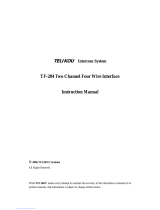
Clear-Com®
MS-702 Two-Channel Main Station Instruction Manual
2-8
in normal operation. The default position of the switches is in the off (up)
position. The function of each switch is as follows:
1. MOM TALK A: Setting the momentary talk A switch to the on
position will disable the latching function of the channel A talk
button. In this mode, the talk button must always be held in
continuously while the operator is talking on channel A.
2. MOM TALK B: Setting the momentary talk B switch to the on
position will disable the latching function of the channel B talk
button. In this mode, the talk button must always be held in
continuously while the operator is talking on channel B.
3. CALL ON TALK A: If the call on talk A switch is set to the on
position, a call signal will be placed on channel A whenever the talk
function is activated. This can be used to activate any call-activated
functions available on other stations.
4. CALL ON TALK B: If the call on talk B switch is set to the on
position, a call signal will be placed on channel B whenever the talk
function is activated. This can be used to activate any call-activated
functions available on other stations.
5. INTRPT ANNC: If the interrupt announce switch is set to the on
position, pressing the announce button will disconnect the
microphone from the intercom line(s). This will allow
announcements to be made without being heard over the intercom
channels.
6. INTRPT EXT IFB: When the hot mic output is connected to
Clear-Com’s IFB system and the interrupt external IFB switch is set
to the on position, pressing a key on the IFB system will disconnect
the selected headset or panel microphone from the intercom line(s).
This allows the MS-702 microphone to be used to cue talent without
affecting intercom line communication.
7. LONG LINE A: If a long cable run on channel A is unavoidable and
approaches 1,000 ft. (305 m) or more, set the long line A option
switch to the on
position. The ability to set a sidetone null on channel
A depends upon properly setting this switch.
8. LONG LINE B: If a long cable run on channel B is unavoidable and
approaches 1,000 ft. (305 m) or more, set the long line B option
switch to the on position. The ability to set a sidetone null on channel
B depends upon properly setting this switch.
16. Termination Switches: These switches provide switchable terminations
for channels A and B. In most systems, both terminations on the MS-702
should be in the on position (default setting). The fundamental concept of
the Clear-Com party-line intercom is that all channels are terminated in
one location, preferably at a main station or power supply. The
termination switches on the MS-702 rear panel should be set to the off
position only if the channel is terminated by another main station or
power supply in the system. If there are no other main stations, power
supplies, or other terminations on the line, set the rear panel switches
labeled term A and term B to the on position.
Note: All intercom lines must be terminated only once, whether they are
used or not. Never “double-terminate” a line.
























